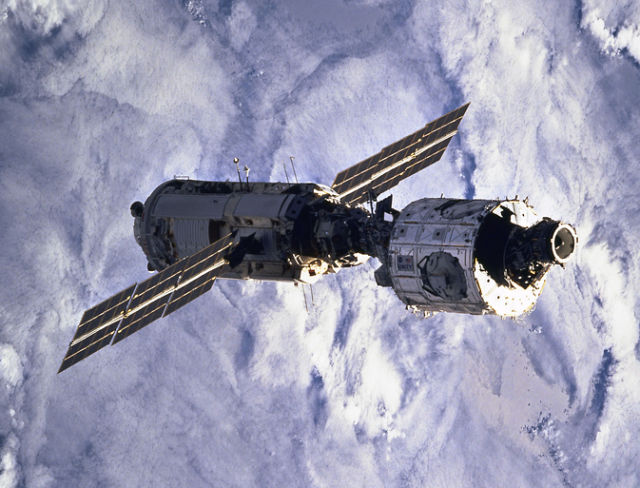Plugging leaks —
“We heard that basically the program office had a runaway fire on their hands.”

Launched in 2000, the Zvezda Service Module provides living quarters and performs some life-support system functions.
NASA
NASA and the Russian space agency, Roscosmos, still have not solved a long-running and worsening problem with leaks on the International Space Station.
The microscopic structural cracks are located inside the small PrK module on the Russian segment of the space station, which lies between a Progress spacecraft airlock and the Zvezda module. After the leak rate doubled early this year during a two-week period, the Russians experimented with keeping the hatch leading to the PrK module closed intermittently and performed other investigations. But none of these measures taken during the spring worked.
“Following leak troubleshooting activities in April of 2024, Roscosmos has elected to keep the hatch between Zvezda and Progress closed when it is not needed for cargo operations,” a NASA spokesperson told Ars. “Roscosmos continues to limit operations in the area and, when required for use, implements measures to minimize the risk to the International Space Station.”
What are the real risks?
NASA officials have downplayed the severity of the leak risks publicly and in meetings with external stakeholders of the International Space Station. And they presently do not pose an existential risk to the space station. In a worst-case scenario of a structural failure, Russia could permanently close the hatch leading to the PrK module and rely on a separate docking port for Progress supply missions.
However, there appears to be rising concern in the ISS program at NASA’s Johnson Space Center in Houston. The space agency often uses a 5×5 “risk matrix” to classify the likelihood and consequence of risks to spaceflight activities, and the Russian leaks are now classified as a “5” both in terms of high likelihood and high consequence. Their potential for “catastrophic failure” is discussed in meetings.
In responding to questions from Ars by email, NASA public relations officials declined to make program leaders available for an interview. The ISS program is currently managed by Dana Weigel, a former flight director. She recently replaced Joel Montalbano, who became deputy associate administrator for the agency’s Space Operations Mission Directorate at NASA Headquarters in Washington.
One source familiar with NASA’s efforts to address the leaks confirmed to Ars that the internal concerns about the issue are serious. “We heard that basically the program office had a runaway fire on their hands and were working to solve it,” this person said. “Joel and Dana are keeping a lid on this.”
US officials are likely remaining quiet about their concerns because they don’t want to embarrass their Russian partners. The working relationship has improved since the sacking of the pugnacious leader of Russia’s space activities, Dmitry Rogozin, two years ago. The current leadership of Roscosmos has maintained a cordial relationship with NASA despite the high geopolitical tensions between Russia and the United States over the war in Ukraine.
The leaks are a sensitive subject. Because of Russian war efforts, the resources available to the country’s civil space program will remain flat or even decrease in the coming years. A dedicated core of Russian officials who value the International Space Station partnership are striving to “make do” with the resources they have to maintain its Soyuz and Progress spacecraft, which carry crew and cargo to the space station respectively, and its infrastructure on the station. But they do not have the ability to make major new investments, so they’re left with patching things together as best they can.
Aging infrastructure
At the same time, the space station is aging. The Zvezda module was launched nearly a quarter of a century ago, in July 2000, on a Russian Proton rocket. The cracking issue first appeared in 2019 and has continued to worsen since then. Its cause is unknown.
“They have repaired multiple leak locations, but additional leak locations remain,” the NASA spokesperson said. “Roscosmos has yet to identify the cracks’ root cause, making it challenging to analyze or predict future crack formation and growth.”
NASA and Russia have managed to maintain the space station partnership since Russia’s invasion of Ukraine in February 2022. The large US segment is dependent on the Russian segment for propulsion to maintain the station’s altitude and maneuver to avoid debris. Since the invasion, the United States could have taken overt steps to mitigate against this, such as funding the development of its own propulsion module or increasing the budget for building new commercial space stations to maintain a presence in low-Earth orbit.
Instead, senior NASA officials chose to stay the course and work with Russia for as long as possible to maintain the fragile partnership and fly the aging but venerable International Space Station. It remains to be seen whether cracks—structural, diplomatic, or otherwise—will rupture this effort prior to the station’s anticipated retirement date of 2030.